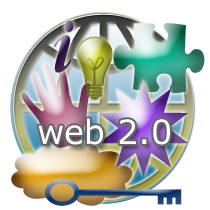|
WEB 2.0 SERIES: Part 1
 Web 2.0 has taken the Internet by storm. People of all ages use the new social media capabilities to connect with others, learn, dialogue, and explore. But only a small percentage of web site owners utilize Web 2.0 capabilities on their website. This new series of articles will help you to make your site Web 2.0 capable. This week we look at What 2.0 is and why it is worth paying attention to.
Web 2.0 has taken the Internet by storm. People of all ages use the new social media capabilities to connect with others, learn, dialogue, and explore. But only a small percentage of web site owners utilize Web 2.0 capabilities on their website. This new series of articles will help you to make your site Web 2.0 capable. This week we look at What 2.0 is and why it is worth paying attention to.
What is Web 2.0?
Essentially, Web 2.0 is a concept that shapes the online landscape into a platform for social connection, sharing, dialogue, and multimedia enhanced interaction. The goal? To promote social networking and creativity. It isn't really a "new" world wide web. Rather, it is a new perspective of how to use the Web to really capitalize on its' ever-evolving capabilities. With the advent and usability of social software applications like blogs, wikis, folksonomies, video-sharing, community software, and mobile access, the structure and tools for Web 2.0 evolution were born.
One of the people credited with the launching of the term, Tim O'Reilly described the history of Web 2.0 as:
"The concept of "Web 2.0" began with a conference brainstorming session between O'Reilly and MediaLive International. Dale Dougherty, web pioneer and O'Reilly VP, noted that far from having "crashed", the web was more important than ever, with exciting new applications and sites popping up with surprising regularity. What's more, the companies that had survived the collapse seemed to have some things in common. Could it be that the dot-com collapse marked some kind of turning point for the web, such that a call to action such as "Web 2.0" might make sense? We agreed that it did, and so the Web 2.0 Conference was born." ( O'Reilly, 2005, pgh.2).
Key Principles of Web 2.0
Tim O'Reilly listed a number of important principles that distinguish Web 1.0 (the "old" web) and Web 2.0.
- The Web as a Platform - web sites can be used to offer social networking, information sharing, and creative activities to ALL internet users
- Harnessing Collective Intelligence - many applications have been created to help web owners to share the knowledge wealth, so to speak. Hyperlinking,directories, wikis, photo and video sharing, folksonomies, blogs, open source software, all contribute to this attribute
- Databases are Critical - database information and applications are key to the smooth operation of Web 2.0 and are "built-in" with many of the social networking softwares available
- End of the Software Release Cycle - updates should be seamless, users can be co-creators
- Lightweight Programming Models - simple programming models are the key
- Software above the Level of a Single Device - this means software can be accessed via a PC, plus other media such as ipods, cellphones, Blackberries, MACs
- Rich User Experiences - use of new techniques can enhance the users' experience with visuals, sound, access control
Applying the Capabilities
Since the launch of the most common Web 2.0 applications, virtually all disciplines have begun to explore its capabilities within their own arenas. Healthcare, education, finance, science, fine arts, politics are examples of disciplines engaged in this exploration - not to mention, everyday web surfers who use them in their own personal communications and interactions.
In coming articles, I will discuss how you, the web site owner can take advantage of many of the same Web 2.0 applications that these pioneers are utilizing. To get an idea of some of the programs and online services available to do this, try exploring Go2Web20.net - The Complete Web 2.0 Directory!
It is a given - successful web site owners of the future are going to incorporate Web 2.0 capabilities into their online structure and content. Isn't it time you began to consider how you can utilize Web 2.0 to really reach out and engage with your online visitors?
Watch a brief introductory Youtube video on the advent of Web 2.0
to page 3 |